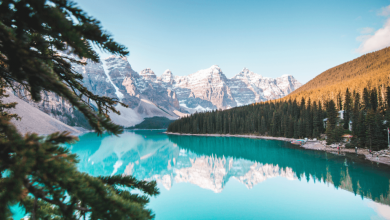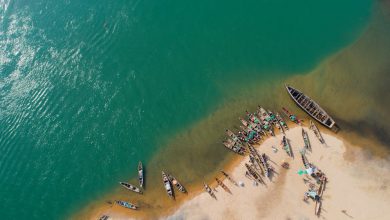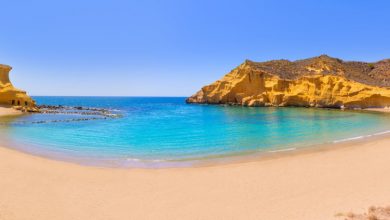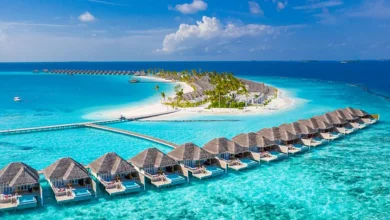Top 10 best places to see Canada’s spectacular Northern Lights
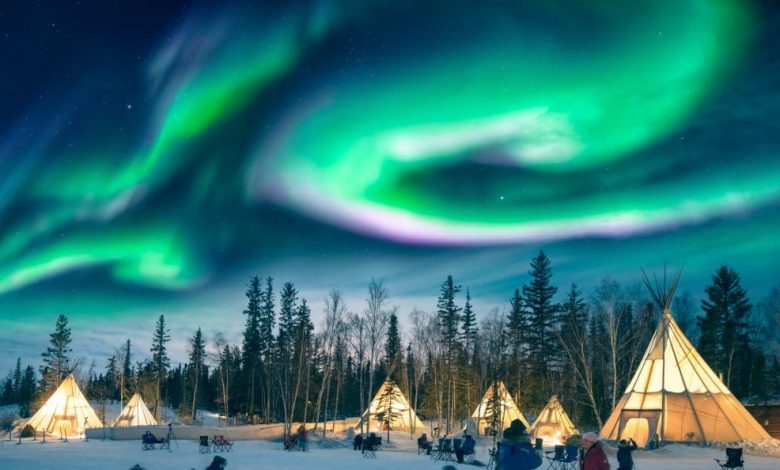
An aurora borealis is a bit like a star: it is elusive, superb, and is desired. Also known as “boreal glow,” this phenomenon is so stunning and sublime that people from all over the world travel in hopes of witnessing it.
Here is a short guide that will help you find the perfect places and times to admire the Northern Lights in Canada. Follow our advice and make the most of the experience – whether from a comfortable observation pod in a teepee village in the Northwest Territories, or from a remote mountain base camp in Newfoundland and -Labrador.
What is causing the phenomenon?
In the Northern Hemisphere, the so-called “aurora borealis” is the result of the interaction between electrically charged solar particles from the solar wind and gases in the Earth’s atmosphere – namely oxygen and nitrogen. . It is when the sun is most active that you are most likely to witness an extraordinary spectacle. The name “aurora borealis” is inspired by mythology: Aurora was the Roman goddess of dawn, and Boreas the Greek god of the north wind. A large part of Canada’s northern territories is located under the auroral oval of the northern hemisphere, in an area where conditions are particularly favorable for observing the northern lights.
What makes this phenomenon so special?
First of all, the Northern Lights are fleeting – which makes it all the more interesting. This is a breathtaking natural phenomenon that is impossible to predict. That said, you still have a good chance of attending it, especially in the North, near the magnetic pole. The Northern Lights are characterized by their fantastic hues, and can take all kinds of shapes: arcs, undulating curtains, misty trails, or even translucent clouds. They come in different colors, from mysterious green to shimmering mauve, including shades of pink and yellow. Green is the most commonly seen color, while red is rare. All these colors zigzag and move surprisingly fast – some say they “dance” – in the indigo of the night sky.
Newfoundland and Labrador
Do you like solitude? That’s good! In Newfoundland and Labrador , and especially in the vast virgin spaces of Labrador, magnificent wilderness awaits you. During the winter, it is possible to travel by snowmobile on nearly 1,500 kilometers of trails, in the dancing light of the Northern Lights. If that’s not enough for you, you can also put on snowshoes, go cross-country skiing, go hunting or ice fishing.
Summer – Perhaps it is during an expedition to Torngat Mountains National Park , a unique adventure on the Labrador Peninsula, that you will observe the most spectacular manifestation of the phenomenon. In this park, which impresses with its unusual geology and its four billion year old rock formations, the traditional way of life of the Inuit has been preserved. Open every summer, the Torngat Mountains base camp and research station located in this remote region allow you to get closer to this land, the Inuit elders who live there and the researchers who study it, but also to witness to an unforgettable spectacle of the Northern Lights in a wild natural setting.
Alberta
Imagine the scene: in front of the imposing Canadian Rockies appears an aurora borealis, whose shimmering colors are reflected in the shimmering waters of glacial lakes. Difficult to find better, right? No wonder northern Alberta serves as the base for Athabasca University’s Geophysical Observatory, which studies the magnetic effect exerted by the Northern Lights on Earth. Even if you’re not scientifically inclined, Banff National Park is worth a visit, if only for the excellent observation posts found there.
Fall – Total darkness after dark and minimal light pollution make Banff National Park the ideal place to view the Northern Lights. You are most likely to see them from September to mid-May, but the advantage in autumn is that you can observe them comfortably, and take advantage of the trip to go camping or go hiking. other must-do activities in the Rockies, like hiking and paddling excursions. Visit the Aurora Watch website for the best times to view the Northern Lights. Their glow can often be seen from Banff, but the ideal is to observe them far from any human activity. Lake Minnewanka is easy to access, and it’s one of the best viewing spots for the phenomenon – just 10 minutes from town! You can also try the Castle intersection , on the road to Lake Louise, the blue-green Peyto Lake , or the ever-popular Herbert Lake . Don’t forget to make a detour to the two largest dark sky reserves in the world: Wood Buffalo National Park – home to a herd of 5,000 free-ranging bison – and Jasper National Park , renowned for its magnificent landscapes. . Set up camp, roll out your warm sleeping bag, and prepare to stay up late.
Ontario
Although the chances of spotting the aurora borealis are higher a little further north and in the Arctic, this elusive phenomenon is regularly observed in lower latitudes of Canada, including parts of Ontario .
Fall – In Ontario, September and October are the best months for viewing the Northern Lights. The optimal conditions for enjoying this sublime nocturnal spectacle are outside cities and in a dark place. Manitoulin Island, Cree Village Ecolodge and Pukaskwa National Park are some of the best places to see them. For the most complete experience, visit an outfitter specially designed to facilitate Northern Lights viewing, such as Killarney Mountain Lodge , Gordon’s Park Eco Resort or Moosonee . And if you’re traveling north in search of the Northern Lights, take the opportunity to discover other attractions and outdoor activities offered in Northern Ontario. Bordered by Hudson Bay and the Great Lakes, this magnificent, still little-known wilderness region is well worth the detour!
Northwest Territories
In theory, it is possible to see the Northern Lights (almost) everywhere in Canada, all year round. However, most of the time, it is in the North that they are most active: this is where you have the best chance of seeing them. Additionally, remote communities with little to no light pollution make the best observation posts. It is impossible to observe the Northern Lights through the clouds. Therefore, if you are on the coast – for example in British Columbia – avoid coastal clouds and head north. Next, look for heights. It’s often in winter (December to March) that you’ll see the most Northern Lights, as it’s during this season that the hours of darkness are longest and the nights are cold and clear. The meeting time? Around midnight: everything happens between 10 p.m. and 2 a.m., so be prepared to stay up late! The lucky ones will see the Northern Lights anywhere in Canada… For the others, here is a list of places that make the best observation posts.
The Northwest Territories is the best place in Canada – and perhaps the world – to see the Northern Lights. They are generally visible there 240 days a year! Autumn and winter are the best seasons for observing them (even if the spectacle is also worth seeing in summer ).
Fall – If you have a bit of a lone bear side, hop on a bush plane in Yellowknife and take a scenic drive to Blachford Lake Lodge & Wilderness Resort , which will delight you with its rustic elegance. Admire the Northern Lights from the spa on the terrace, or you prefer to sit on the rounded rock that overlooks the water, not far away. But there is still more! You can admire the spectacle while hiking or while teasing fish or paddling.
Winter – The Northern Lights are particularly spectacular in winter, when they stand out against the whiteness of magnificent frozen landscapes. To enjoy the show, the easiest way is to make yourself comfortable in Aurora Village , a teepee village located very close to Yellowknife. Specially designed to facilitate the observation of the Northern Lights, the site is equipped with spacious tepees heated by wood stoves, sofas covered in furs, and heated and reclining observation capsules.
Manitoba
Northern Manitoba is located in the subarctic region, on the shore of Hudson Bay. Up there is Churchill , which bills itself as “one of the three best places on the planet” to see the Northern Lights. In fact, many scientists from around the world come to study this phenomenon in this town of 850 inhabitants known for its polar bears. To make your visit even more memorable, get to know the local wildlife: if you’ve never seen belugas, polar bears or arctic foxes, this is the perfect opportunity! The ideal is to pass through Winnipeg and stop at the Manitoba Museum to learn more about the Northern Lights and learn how to photograph them properly.
Late winter – February and March is peak northern lights season in Churchill , as temperatures are extremely low – they can drop to minus 40 degrees Celsius! Accompanied by an experienced guide from the Frontiers North tourism company , set off around midnight aboard a Tundra Buggy, a heated all-terrain vehicle equipped with a bar. Carry extra batteries – batteries sometimes die when temperatures drop – and rent suitable clothing from Polar Inn & Suites . Photograph the explosion of colors or, better yet, just keep your eyes wide open so as not to miss a moment of the spectacle.
Autumn – The second best period for observing the Northern Lights is from September to November. Until mid-September, vary the pleasures by combining Northern Lights viewing from the comfortable terrace of the Aikens Lake Wilderness Lodge and trophy fish fishing, all just a two-hour flight from Winnipeg.
Yukon
Since the time of the gold rush, the Yukon , territory of the Wild West, has served as a setting for legendary adventures. It’s your turn to be an adventurer! From September to April, try your hand at dog sledding, “fat biking” (a bicycle with oversized tires) and roughing it in the open air like prospectors – and take advantage of your journey to contemplate the famous auroras boreals. In summer the night sky is not dark enough, due to the midnight sun, but this phenomenon is an excellent reason to visit the region!
Fall – Set up camp in the wilderness like the prospectors of old, near Whitehorse, on a starlight – and aurora borealis – excursion organized by Northern Tales . Rest assured, this outfitter has provided some essential comfort elements for modern creatures like us: barrels converted into stoves and steaming drinks allow you to wait without suffering from the cold.
Late Winter and Early Spring – In the winter, Northern Tales offers a variety of Northern Lights-themed packages and excursions , including activities like snowshoeing, ice fishing, snowmobiling and dog sledding. You can also cozy up in a sumptuous, well-insulated yurt or cozy teepee at Arctic Range Adventures ‘ AuroraCentre . Add to that wildlife viewing, dog sledding and relaxing in the Takhini Hot Springs . What more? The mountain bike professionals from the company Boréale Explorers offer guided excursions combining winter cycling and observation of the Northern Lights, but also packages combining snowmobiling or dog sledding and the Northern Lights. The base camp, located near Whitehorse, consists of an elegant ecological lodge and “Yurtville”, a set of yurts.
Nunavut
Its vast expanses of tundra and its location (the Far North!) make the Canadian Arctic a destination of choice for observing the Northern Lights. In spring and summer in Nunavut , the sun seems to shine continuously: 16 hours a day from May to August, and without interruption in June and July. For the Northern Lights, the ideal is therefore to target the period between October and April, during which the nights are the longest. In December, for example, there are no more than four hours of light per day. It is therefore during this time of year that locals most often have the opportunity to admire the undulations of the Northern Lights.
Winter – Why not travel to a remote, traditional Inuit community like Kimmirut , where you can kayak and see icebergs? Unless you choose Whale Cove, so you can go fishing and try to spot beluga whales after a night of viewing the Northern Lights.
Early fall – Take advantage of the daylight to follow the routes traditionally taken by caribou, then, at nightfall, admire the Northern Lights from the Arctic Haven Wilderness Lodge, which is located at an ideal latitude for observation of this phenomenon. In this region, it is on a cool autumn evening that you are most likely to admire the Northern Lights. Located in the Arctic tundra on the shores of Ennadai Lake, west of Hudson Bay, this lodge is only a few hours by bush plane from Yellowknife (Northwest Territories). On site, in addition to the fabulous light show, you can admire the flamboyant fall colors and the wildlife of the region, including grizzly bears and wolves. Pack layerable clothing and sturdy hiking shoes, and expect ever-changing weather conditions.
